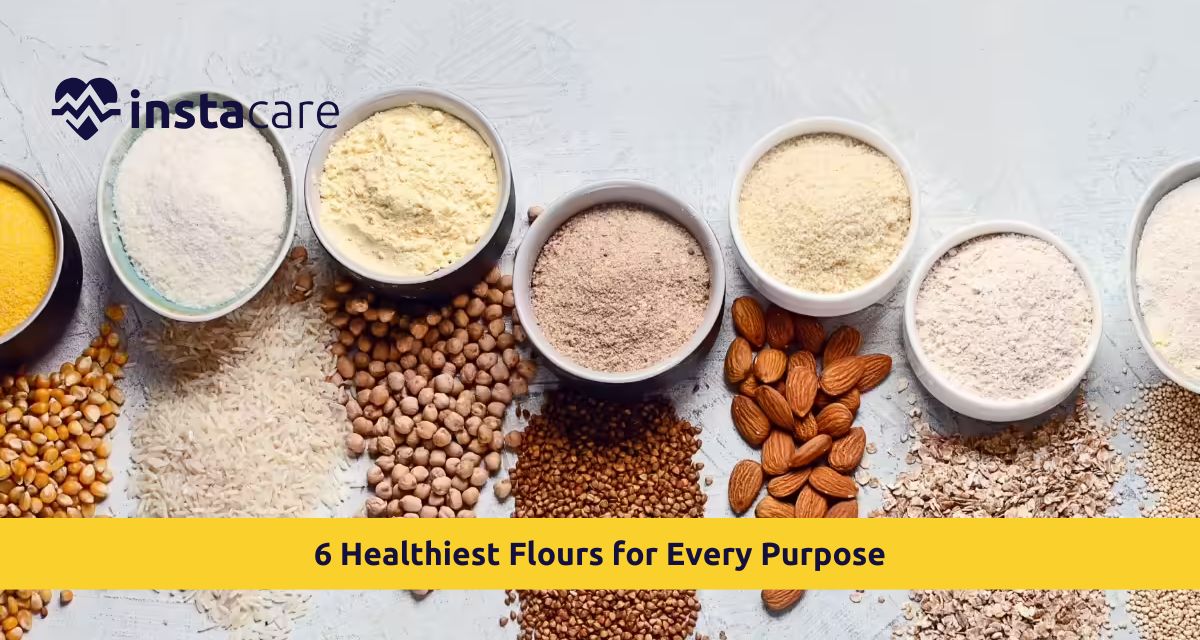There's one pantry staple in every home on the planet: flour. Pancake mix and pizza crust to homemade doughnuts and dessert, it's the start of a thousand meals. No two flours are alike, however. With food intolerance at an all-time high, clean eating and low-carb diets, choosing the perfect flour is no longer about taste and texture, it's about health.
Some people bake for better digestion, some bake for controlling diabetes; for others, it is fortifying the food with more nutrients. Knowing what baking flour is the healthiest can easily change that for those kinds of scenarios. Here is a primer to the six healthiest flours for baking and how to apply them, along with a few tips on how to choose the optimal flour according to your diet.
Why Flour Choice Matters?
The flour could taste and smell stale and dead, but what your body does with it after the fact is most important. The white flour is heavily processed and robs it of the nutrients and the fiber. That will make the
blood sugar spikes and insatiability. The nutrient-rich flours are left with their natural texture and provide actual health dividends.
For instance, diabetics should use low glycemic index flour to ensure that it does not raise your blood glucose. Similarly, good weight-loss flour must contain good proteins and fibers to ensure you remain longer in duration. Optimal flours for gut health can make your gut healthy, give energy, and remain diet-free like keto or gluten-free flour options.
Top 6 Healthiest Flours and Best Uses
The following six healthy multi-purpose flours, high fiber flour types, each with their best uses and positives, are detailed below:
1. Almond Flour
Almond flour benefits are everyone's delight for health. It is blanched almond ground, naturally gluten-free.
- Nutrition: Healthy fat content, vitamin E, protein, and magnesium.
- Best for: Keto baking, cookies, muffins, breading proteins.
- Health benefit: One of the great flours to utilize on low-carb diet; best utilize in best flour for keto diet as part of an attempt to gain and fight inflammation.
Light nutty taste and sweetness, best utilize in baked recipe. And it's also diabetic blood sugar-friendly flour so best for diabetics patients.
2. Coconut Flour
Coconut flour is a form of flour that is produced from coconut meat which has undergone dehydration. Coconut flour is considered to have great nutritional properties since it is a super-dense flour.
- Nutrition: coconut flour nutrition contains a remarkable concentration of high fiber and medium-chain triglycerides (MCTs) and is packed full of iron.
- Best for use in: Pancakes, Brownies, and Grain-Free Breads.
- Health Bonus: One of the highest-fiber flours that aid digestion and promote heart health.
It absorbs water; therefore, it needs extra eggs or liquids. Keep it to about one-fourth of normal flour whenever mixed, and always use with binding agents.
3. Oat Flour
If you’re looking for a familiar flavor and texture, between oat flour vs wheat flour, oat flour is a winner. It’s simply ground oats, no processing, no additives.
- Nutrition: Good source of beta-glucan fiber, iron, and B vitamins.
- Best for: Muffins, banana bread, pancakes, and cookies.
- Health advantage: Higher in fiber and lower in digestively taxing than wheat flour, oat flour beats out wheat flour.
Easy on the digestive system and pleasant on cholesterol control, it's a improved digestion option.
4. Quinoa flour
Don't reserve quinoa for salads, quinoa flour is a healthy, gluten-free protein flour. quinoa flour uses are much more than that:
- Nutrition: All 9 amino acids, iron, magnesium, fiber.
- Best for: Protein muffins, flatbreads, or use as a flour substitute blended with other flours for baking.
- Health benefit: Vegetarians' or protein fanatics' glaze is produced by quinoa flour.
It possesses a light earthy flavor that is ideal to use as an accompaniment for sweet or savory food, providing texture and depth to as light as rice or oat flour.
5. Spelt Flour
Spelt flour is old wheat that's back in style. Even though it does contain gluten, there are people who still find it easy to eat because it's kinder to their system than processed wheat. There are several spelt flour health benefits.
- Nutrition: Extremely high in fiber, protein, zinc, and manganese.
- Best used with: Use when making bread, pancakes, pasta, and pizza crust.
- Health benefit: The health benefit of the whole wheat flour is enhanced cardiovascular and digestion health.
There is a light nutty flavor and 1:1 substitution that is so versatile to employ most recipes, especially in texture.
6. Whole Wheat Flour (and Other Whole Grains)
Don't deprive yourself of whole grain flour types like whole wheat, buckwheat, barley, and rye. They are dense with bran and germ and therefore are healthier.
- Nutrition: B vitamins, iron, selenium, and fiber.
- Best for: Every day baking, breads, muffins, pancakes, and crackers.
- Health advantage: They are high fiber flour ideal for weight management and digestive health.
The simplest way of getting nutritional value in diet is by including whole grain rather than white flour.
How to Select Correct Flour based on Your Requirement
All flours are not the same. There is a specific use of every flour. Your choice will be made depending on your requirement, your taste, and your nutritional need.
- For weight loss: Use the low-carb and high-fiber ones. Almond, coconut, or quinoa flour would work for weight loss because they are blood sugar-friendly as well as filling.
- For gluten-free diet: Keep some sources such as almond, coconut, oat (gluten-free labeled), and quinoa. They can substitute without harming health.
- For diabetics: Use low-glycemic-index flour for diabetics. Almond flour and coconut flour are good combinations with blood sugar control.
- For baking: Where structure is a requirement (i.e., with breads), employ whole wheat flour or spelt flour. Oat flour or almond flour for fewer baked goods.
- For keto or low-carb diets: Coconut flour and almond flour are optimal low-carb flours to employ in keto diets as they contain lesser carb but plenty of healthy fat.
Between wheat and oats, keep in mind that oat flour is flavorless. However, it is softer to the touch and low in gluten form.
Tips Regarding Storing Flours and Their Usage
Home, when purchasing such flours, usage and storage are concerns.
- Store well These of these rich nutrient-dense flours like almond and coconut flours are oil flours with a short shelf life. Store them tightly capped in the fridge or freezer to shelf-stabilize them.
- Mix to provide the best results Whole flours also yield best results when blended with other whole flours. Almond and coconut, or oat and quinoa flour, add the blended flavor and texture.
- Begin incorporating 25% improved flour in your normal flour. Begin substituting small quantities as you acclimatize to the different flavor and texture.
- Modify liquid ratio Fibrous flours like coconut hold water, and recipes will need extra egg, oil, or milk.
Conclusion
The correct flour isn't a choice when it comes to baking, it's a health he;ritage. It's low-carb flours and gut-friendly flours, and dozens more, something for every nutritional requirement and dietary requirement. Regardless of whether you require the most healthy flour upon which to cook and bake in the quest to optimize wellness, regulate blood sugar, or even try to optimize best flour for weight loss, the great news is: you don't have to compromise on taste and texture in doing so as a way to nourish yourself.
Please book an appointment with the
Best Nutritionist in Lahore, Karachi, Islamabad, and all major cities of Pakistan through
InstaCare, or call our helpline at 03171777509 to find a verified doctor for your disease.

